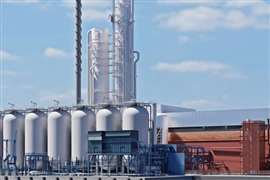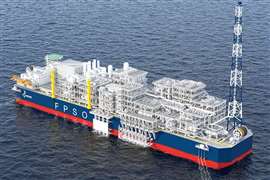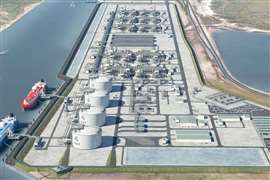Global Gas Report 2025: Natural gas demand rises amid volatility, renewables integration, and push for low-carbon fuels
September 09, 2025
Asia and Europe lead divergent demand trends as LNG trade expands and decarbonization efforts accelerate
The latest edition of the Global Gas Report 2025, produced by the International Gas Union (IGU), Snam and Rystad Energy, underscores the enduring role of natural gas in the global energy system while warning of heightened volatility and urgent decarbonization challenges. The 90-page report shows that natural gas demand continued to grow in 2024 and is expected to increase further in 2025, supported by power generation needs, weather-related demand spikes, and the fuel’s ability to complement variable renewable energy (VRE). At the same time, it highlights geopolitical disruptions, shifting trade flows, and an accelerating focus on low- and zero-carbon gases.

Global natural gas consumption rose to 4,122 billion cubic meters (Bcm) in 2024, an increase of 78 Bcm, or 1.9%, from the previous year. Growth was led by Asia and North America, where demand for gas-fired power generation rose sharply amid extreme seasonal heatwaves. Power accounted for one-third of global demand growth, with consumption rising by 39 Bcm, or 2.8%, in 2024.
The report projects another 71 Bcm (1.7%) increase in 2025, though growth trajectories diverge across regions. Europe saw a resurgence in LNG imports during the first half of 2025, rising 16 Bcm, or nearly 24%, compared with the same period in 2024 . North America also registered demand growth of 1.5%. By contrast, Asia’s gas demand slowed under the weight of higher spot LNG prices and weak macroeconomic conditions, with China’s LNG imports falling by nearly 20% in the first half of 2025.
“The global gas market remains tightly balanced, with supply growth just matching demand gains,” the report noted. “Geopolitical events, policy shifts, and extreme weather continue to reshape demand patterns and trade flows.”
Expanding LNG trade
LNG remains the fastest-growing segment of the global gas market. Global LNG trade reached a record 555 Bcm in 2024, up for the 11th consecutive year . The United States consolidated its position as the top exporter at 116 Bcm, followed by Australia (110 Bcm) and Qatar (107 Bcm). China remained the largest net importer at 105 Bcm, though its intake slowed in 2025.
The resilience of the LNG value chain was tested by multiple disruptions in 2024 and 2025. Attacks on shipping in the Red Sea, drought-related constraints at the Panama Canal, and geopolitical flare-ups in the Middle East forced vessels to reroute, often around the Cape of Good Hope. Despite these headwinds, LNG’s role as a flexible, tradable energy source continued to expand.
New supply capacity also came online. The Greater Tortue Ahmeyim project in Mauritania and Senegal and LNG Canada both began operations in early 2025. Additional capacity from projects in the U.S. Gulf Coast, including Plaquemines LNG and Corpus Christi, as well as Congo’s Nguya floating LNG facility, is expected to further boost supply. Overall, liquefaction capacity grew by about 9 Bcm in 2024 and is projected to expand by 87 Bcm in 2025.
The report highlights the vulnerability of global gas trade to geopolitical shocks. In June 2025, Israel halted production at its Leviathan and Karish fields for nearly two weeks during a conflict with Iran. Simultaneously, drone attacks damaged Iran’s South Pars Phase 14 plant, briefly curtailing output. Meanwhile, the termination of Russian pipeline flows through Ukraine at the start of 2025 reshaped European supply dynamics, forcing increased reliance on LNG.
The report also noted that U.S. LNG has emerged as a bargaining chip in trade negotiations. Recent tariff measures under the Trump administration have sharpened focus on American exports as a tool in bilateral economic relationships.
Prices volatile but subdued
Benchmark prices eased from the extreme highs of 2022–23 but remained volatile. TTF averaged $11/MMBtu in 2024, down 17% year-on-year, while Henry Hub rose to a two-year high of $4.30/MMBtu in early 2025. By mid-February 2025, TTF briefly spiked to $17.60/MMBtu amid a European cold snap and concerns over storage levels.
Price volatility remains a challenge for buyers, particularly in Asia’s price-sensitive markets. India and China limited spot purchases in early 2025, while Europe competed aggressively for cargoes to rebuild depleted storage.
Gas and renewables integration
One of the report’s central themes is gas’ role in enabling renewable integration. Global electricity demand is expected to nearly double by 2050, with renewables accounting for the majority of installed capacity. However, the intermittency of wind and solar creates system instability that batteries alone cannot solve.
The report points to “dunkelflaute” events—extended periods of low wind and solar output—that hit Germany and Australia in 2024, forcing surges in gas-fired generation. In Australia, wholesale prices briefly exceeded AUD 5,000/MWh in July 2024 due to low wind output during peak demand.
Natural gas, the report argues, is the most mature, responsive, and scalable source of dispatchable power today. With modest capital costs and integration into global LNG markets, gas-fired generation remains essential for grid stability during extreme weather, prolonged droughts, or cold snaps.
Still, the economics of flexible gas-fired plants remain challenging. Operating in peaking roles reduces revenue hours and weakens project economics. To address this, countries are introducing reforms such as capacity payments and long-term contracts. Japan and Italy have implemented capacity markets to support investment in backup gas capacity.
Low-carbon gases and decarbonization
The Global Gas Report 2025 devotes significant attention to low-carbon gases, including biomethane, hydrogen, and carbon capture, utilization and storage (CCUS).
Biomethane is highlighted as the most immediately scalable option. Production grew sevenfold over the past decade to 9.6 Bcm in 2024, largely driven by European feed-in tariffs. The report projects global biomethane output to grow by 14% annually through 2040, reaching 75 Bcm. With mature technology and compatibility with existing gas infrastructure, biomethane offers near-term opportunities for waste management, energy security, and grid flexibility.
Hydrogen and hydrogen derivatives are advancing more slowly, with higher costs limiting adoption. Still, 2024 marked a record year for clean hydrogen projects reaching final investment decision (FID), totaling 1.9 Mt. Post-FID volumes tripled to 0.8 Mt. The report stresses that stronger policy frameworks, long-term offtake agreements, and carbon pricing are essential to scale the sector.
Meanwhile, CCUS capacity is projected to reach 577 Mtpa globally by 2030, but more than 80% of that remains pre-FID, underscoring the need for clearer regulations and financing support .
Outlook: balancing growth with transition
The Global Gas Report 2025 concludes that natural gas remains indispensable to energy security and the transition to low-carbon systems. Demand is rising, particularly in Asia and North America, while Europe leans more heavily on LNG to secure supplies. At the same time, the industry faces pressure to reduce methane emissions, improve efficiency, and accelerate deployment of low-carbon gases.
“Natural gas serves as a flexible and reliable balancing source, ensuring energy security and system stability amid fluctuations in renewable output,” IGU President Andrea Stegher wrote in the foreword. “But more supportive and pragmatic policies are urgently needed to support accelerated adoption of low- and zero-carbon gas technologies.”
As electrification spreads and renewable penetration deepens, the report argues, investment in both conventional and low-carbon gas infrastructure will be critical to ensuring that the global energy system remains affordable, reliable, and sustainable.
MAGAZINE
NEWSLETTER

CONNECT WITH THE TEAM










